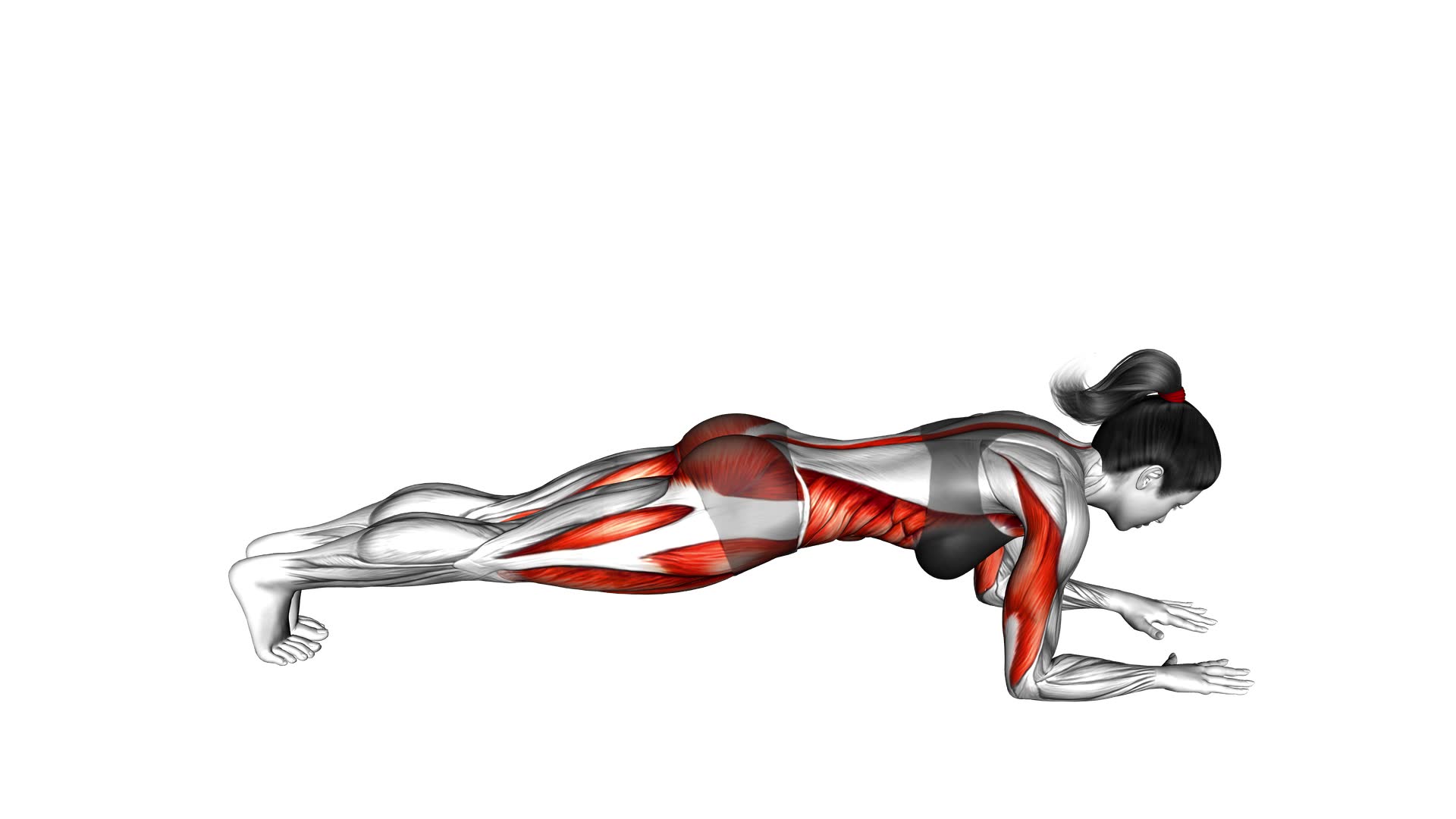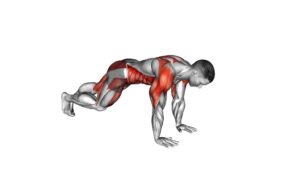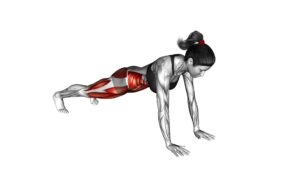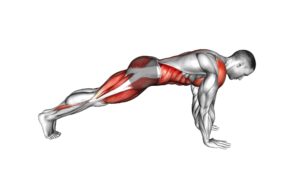Mountain Climber and Dynamic Plank (female) – Video Exercise Guide & Tips

Looking to amp up your workout routine?
Watch This Exercise Video
Check out this video exercise guide and tips for the Mountain Climber and Dynamic Plank!
These challenging exercises offer a multitude of benefits, from strengthening your core to improving cardiovascular endurance.
In this guide, you'll learn the proper form and technique for each exercise, as well as modifications and progressions to suit your fitness level.
Get ready to take your workouts to new heights with the Mountain Climber and Dynamic Plank!
Key Takeaways
- Mountain Climber and Dynamic Plank exercises strengthen core muscles and improve cardiovascular endurance.
- These exercises target multiple muscle groups, enhancing agility and coordination.
- Proper form and technique are essential for both exercises, including maintaining a neutral spine and engaging the core.
- Modifications, progressions, and safety tips can be incorporated to cater to different fitness levels and prevent injuries.
Benefits of Mountain Climber and Dynamic Plank
Get stronger and improve your core stability with the benefits of incorporating mountain climbers and dynamic planks into your workout routine.
Mountain climbers are a great exercise that targets multiple muscle groups, including your abs, shoulders, and legs. By performing mountain climbers, you engage your core muscles and increase your heart rate, leading to improved cardiovascular endurance. Additionally, mountain climbers help to improve your agility and coordination, as they require you to move your legs quickly while maintaining a stable upper body position.
Dynamic plank variations, on the other hand, take the traditional plank exercise to the next level by adding movement and intensity. By incorporating dynamic plank variations into your routine, you challenge your core muscles even more and enhance your overall strength and stability. These variations can include movements such as plank jacks, plank twists, and plank knee tucks, which target different parts of your core and promote greater muscle activation. Dynamic planks also help to improve your balance and flexibility while strengthening your shoulders, arms, and back.
Incorporating mountain climbers and dynamic plank variations into your workout routine offers numerous benefits for your overall fitness. These exercises not only increase your core strength and stability but also enhance your cardiovascular endurance and improve your agility and coordination.
Proper Form and Technique for Mountain Climber
To perform the mountain climber exercise correctly, use proper form and technique. Here are some tips to help you perfect your mountain climber:
- Keep your hands shoulder-width apart and your arms straight.
- Engage your core by pulling your belly button towards your spine.
- Maintain a neutral spine by keeping your back straight and avoiding any sagging or arching.
- Bring one knee towards your chest while keeping the other leg extended behind you.
- Alternate between legs in a smooth and controlled manner, mimicking a running motion.
- Keep your hips low and parallel to the ground to engage your lower abs and glutes.
- Avoid bouncing or jerking movements, as this can put unnecessary stress on your joints.
- Focus on maintaining a steady and controlled pace throughout the exercise.
- To add variety to your workout, try different mountain climber variations such as cross-body mountain climbers or mountain climbers with a twist.
By using proper form and technique, you'll maximize the effectiveness of the mountain climber exercise and avoid common mistakes such as rushing through the movement or allowing your hips to rise too high.
Now, let's move on to the next section about proper form and technique for the dynamic plank.
Proper Form and Technique for Dynamic Plank
To perform the dynamic plank with proper form and technique, there are a few key points to keep in mind.
First, focus on engaging your core muscles throughout the exercise to maintain stability and control.
Second, pay attention to your shoulder position and stability cues, ensuring that your shoulders are stacked directly over your wrists and your shoulder blades are pulled down and back.
Lastly, practice proper breathing techniques, inhaling deeply through your nose and exhaling fully through your mouth to enhance stability and control.
Core Engagement Tips
You can improve your core engagement during the dynamic plank exercise by focusing on proper form and technique. Here are some tips to help you activate and strengthen your core effectively:
- Maintain a neutral spine: Keep your spine in a straight line from your head to your tailbone, avoiding any excessive arching or rounding.
- Engage your abdominal muscles: Draw your belly button towards your spine to activate your deep core muscles.
- Squeeze your glutes: By tightening your glute muscles, you create stability and additional engagement in your core.
- Breathe deeply: Inhale deeply through your nose and exhale fully through your mouth, using your breath to enhance your core activation and stability.
Shoulder Stability Cues
Focus on maintaining stable shoulders while performing the dynamic plank exercise by following these cues. Shoulder stability is crucial for proper form and technique during this exercise. To improve your shoulder stability, incorporate shoulder stability exercises into your workout routine. These exercises can help strengthen the muscles around the shoulder joint, improving stability and reducing the risk of injury.
Benefits of shoulder stability include enhanced upper body strength, improved posture, and reduced shoulder pain. To maintain stable shoulders during the dynamic plank, keep your shoulders stacked directly over your wrists and engage your core muscles. Avoid shrugging your shoulders or letting them collapse.
Breathing Techniques for Stability
Breathe deeply and maintain stability in your dynamic plank by engaging your core and keeping your shoulders aligned with your wrists. Proper breathing techniques are essential for stability in exercise. Here are some tips to help you improve your breathing while performing a dynamic plank:
- Inhale deeply through your nose before you begin the exercise.
- Exhale forcefully through your mouth as you engage your core and lift your knees towards your chest.
- Continue to breathe deeply and rhythmically throughout the exercise to maintain stability and control.
By focusing on your breath and coordinating it with your movements, you can enhance your stability and ensure proper form during the dynamic plank.
Now, let's move on to discussing modifications and progressions for the mountain climber exercise.
Modifications and Progressions for Mountain Climber
To modify and progress the mountain climber exercise, try incorporating variations that challenge different muscle groups and increase intensity. One modification you can try is the Spiderman mountain climber, where you bring your knee towards your elbow as you perform the exercise. This variation targets your obliques and adds an extra challenge to your core.
Another modification is the single-leg mountain climber, where you lift one leg off the ground as you perform the exercise. This variation increases the demand on your hip flexors and requires more stability.
To further progress the mountain climber, you can try adding a twist at the top of the movement, rotating your torso to one side and then the other. This engages your obliques even more and adds a rotational component to the exercise.
By incorporating these modifications and progressions, you can continue challenging your muscles and making the mountain climber exercise more effective.
Now, let's move on to discussing modifications and progressions for the dynamic plank exercise.
Modifications and Progressions for Dynamic Plank
Now it's time to take your dynamic plank to the next level with these advanced modifications. Challenge yourself by adding in movements like knee tucks or shoulder taps to increase the intensity and engage more muscles.
On the other hand, if you're just starting out, try these beginner progressions to build strength and stability before attempting the full dynamic plank.
Advanced Dynamic Plank Modifications
Try these advanced modifications to take your dynamic plank exercises to the next level. Here are some core activation techniques that will challenge your stability and strength:
- Weighted Dynamic Plank: Hold a dumbbell or a weighted plate on your back while performing the dynamic plank. This extra resistance will increase the intensity of the exercise and engage your core muscles even more.
- Single-Leg Dynamic Plank: Lift one leg off the ground and hold it parallel to the floor while performing the dynamic plank. This modification adds an element of instability, forcing your core muscles to work harder to maintain balance.
- Side Plank with Leg Lift: Start in a side plank position and lift your top leg up, reaching it towards the ceiling. This modification targets your obliques and adds a dynamic element to the exercise.
Incorporating these advanced modifications into your dynamic plank routine will help you build a stronger core and take your fitness to new heights.
Beginner Dynamic Plank Progressions
To start progressing your dynamic plank exercise, you can incorporate modifications and progressions designed for beginners. Beginner plank variations are a great way to build strength and stability in your core.
One common mistake in dynamic plank is allowing your hips to sag or lift too high, which puts strain on your lower back. To avoid this, focus on maintaining a straight line from your head to your heels throughout the movement.
Another mistake is holding your breath or forgetting to engage your core muscles. Remember to breathe and actively contract your abs to maximize the effectiveness of the exercise.
Tips for Incorporating Mountain Climber and Dynamic Plank Into Your Workout Routine
Incorporate mountain climbers and dynamic planks into your workout routine for a challenging full-body workout. These two exercises offer a range of benefits, including core activation and upper body strength.
Here are some tips to help you seamlessly integrate mountain climbers and dynamic planks into your fitness regimen:
- Start with a warm-up: Before diving into these intense exercises, it's essential to warm up your muscles to prevent injury. Perform some light cardio exercises like jogging or jumping jacks to get your blood flowing and increase your body temperature.
- Begin with proper form: Maintaining correct form is crucial for maximizing the effectiveness of these exercises. For mountain climbers, keep your hands directly under your shoulders, engage your core, and bring your knees towards your chest one at a time. During dynamic planks, keep your body in a straight line from head to toe, engage your abs, and avoid sagging or arching your back.
- Progress gradually: If you're new to mountain climbers and dynamic planks, start with modified versions and gradually increase the intensity as you build strength and endurance. For example, you can perform mountain climbers with your hands on an elevated surface or start with static planks before progressing to dynamic ones.
Incorporating mountain climbers and dynamic planks into your workout routine will challenge your entire body and help you build core strength and upper body stability. Remember to listen to your body and modify the exercises as needed to prevent injury and achieve optimal results.
Frequently Asked Questions
How Many Calories Can I Burn by Doing Mountain Climbers and Dynamic Planks?
By doing mountain climbers and dynamic planks, you can burn a significant amount of calories. The exact number of calories burned depends on factors such as your body weight and exercise intensity. These exercises are known for their ability to increase heart rate and engage multiple muscle groups, which can lead to a higher calorie burn.
Incorporating mountain climbers and dynamic planks into your workout routine can help you achieve your calorie-burning goals.
Can Mountain Climbers and Dynamic Planks Help Me Lose Belly Fat?
Mountain climbers and dynamic planks are effective exercises for targeting belly fat.
By incorporating mountain climbers into your routine, you engage your core and burn calories.
Dynamic planks, on the other hand, work your entire body, including your abs, obliques, and lower back, helping to strengthen and tone those areas.
When performed correctly, these exercises can contribute to overall fat loss, including the reduction of belly fat.
How Often Should I Incorporate Mountain Climbers and Dynamic Planks Into My Workout Routine?
To incorporate mountain climbers and dynamic planks into your workout routine, it's important to consider your fitness level. Start by modifying the exercises to match your abilities. These exercises offer great benefits when added to a HIIT workout routine.
They increase your heart rate, engage multiple muscle groups, and help burn calories. For optimal results, aim to include mountain climbers and dynamic planks in your routine 2-3 times a week. Remember to listen to your body and rest when needed.
Can Mountain Climbers and Dynamic Planks Help Improve My Core Strength?
Mountain climbers and dynamic planks are excellent exercises for improving core strength. By engaging your abdominal muscles and stabilizing your spine, these exercises can help improve your posture and increase your endurance.
Incorporating them into your workout routine on a regular basis will provide you with a challenging full-body workout that targets your core muscles. With consistent practice, you'll notice improvements in your overall strength and stability.
Are Mountain Climbers and Dynamic Planks Suitable for Beginners?
Mountain climbers and dynamic planks can be suitable for beginners if performed with proper form and technique. To ensure you're doing them correctly, start by maintaining a strong plank position and engaging your core muscles.
For beginners, modifications like performing the exercises with your hands elevated on a bench or starting with slower movements can help build strength and gradually progress.
Remember to listen to your body and consult a fitness professional if needed.
Conclusion
Incorporating mountain climbers and dynamic planks into your workout routine can provide numerous benefits. These exercises improve cardiovascular endurance, strengthen core muscles, and enhance overall body stability.
By following proper form and technique, you can maximize the effectiveness of these exercises. Additionally, modifications and progressions can be implemented to challenge yourself and continue making progress.
So, whether you're a beginner or an advanced fitness enthusiast, give mountain climbers and dynamic planks a try to elevate your fitness journey.

Author
Years ago, the spark of my life’s passion ignited in my mind the moment I stepped into the local gym for the first time. The inaugural bead of perspiration, the initial endeavor, the very first surge of endorphins, and a sense of pride that washed over me post-workout marked the beginning of my deep-seated interest in strength sports, fitness, and sports nutrition. This very curiosity blossomed rapidly into a profound fascination, propelling me to earn a Master’s degree in Physical Education from the Academy of Physical Education in Krakow, followed by a Sports Manager diploma from the Jagiellonian University. My journey of growth led me to gain more specialized qualifications, such as being a certified personal trainer with a focus on sports dietetics, a lifeguard, and an instructor for wellness and corrective gymnastics. Theoretical knowledge paired seamlessly with practical experience, reinforcing my belief that the transformation of individuals under my guidance was also a reflection of my personal growth. This belief holds true even today. Each day, I strive to push the boundaries and explore new realms. These realms gently elevate me to greater heights. The unique combination of passion for my field and the continuous quest for growth fuels my drive to break new ground.







